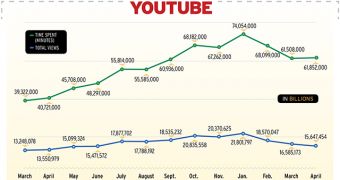YouTube is synonymous with online video and has been since its inception. But online video is changing and that's mostly because of YouTube. Views have always been the heart of the site, videos getting millions or even hundreds of millions of views aren't uncommon.
Views are great if you're looking for coverage, if you want to spread as far as possible and get as many people to your site as possible. But YouTube hardly needs that many more people, it's one of the biggest sites on the planet.
In fact, more people and more views means more expenses for YouTube, storing several copies of billions of videos and serving them to hungry eyes isn't cheap.
That's why, as far Google has revealed, YouTube has never been profitable. It makes quite a lot of money, but it spends them all away.
That's about to change though, at last, as YouTube moves its focus from views and visitors to engagement, keeping people watching longer, better produced videos that bring in a lot more money.
That's compared to most of the videos on the site that don't bring in any money at all since YouTube is wary of monetizing random user videos that may be infringing on someone's copyright, may be in poor taste, violate the site's terms of service or may even be illegal in some places.
Needless to say, advertisers aren't lining up to place their ads next to these videos either. YouTube's hope is long form content, well, long form by YouTube's standards. So, at the start of the year, the entire site started to change focus from views to time watched.
The results are dramatic, whereas YouTube's view count grew feverishly month after month, it started sliding come January. Now, they're about what they were a year ago. Obviously, with less views, time spent on the site dwindled as well. In normal circumstances this would be worrying, but this is by design.
Because, while views and total time spent on the site are down, time spent viewing each video is on the rise, YouTube viewers watch 3.95 minutes per video on average. That's up from 3.39 minutes in January, a significant jump, and from 2.96 minutes in March 2011.
People are watching one minute of video more, on average, than they were a year ago. To achieve this, YouTube has not only been working on creating longer, better videos and series, but it has also been pushing people more towards longer videos, via suggestions, recommendations, featured videos and so on.
All of this comes from a simple change to the ranking algorithm, the time users watch a video is now a stronger indicator than how many clicked to see it the first place, emphasizing quality over shock value.

 14 DAY TRIAL //
14 DAY TRIAL //